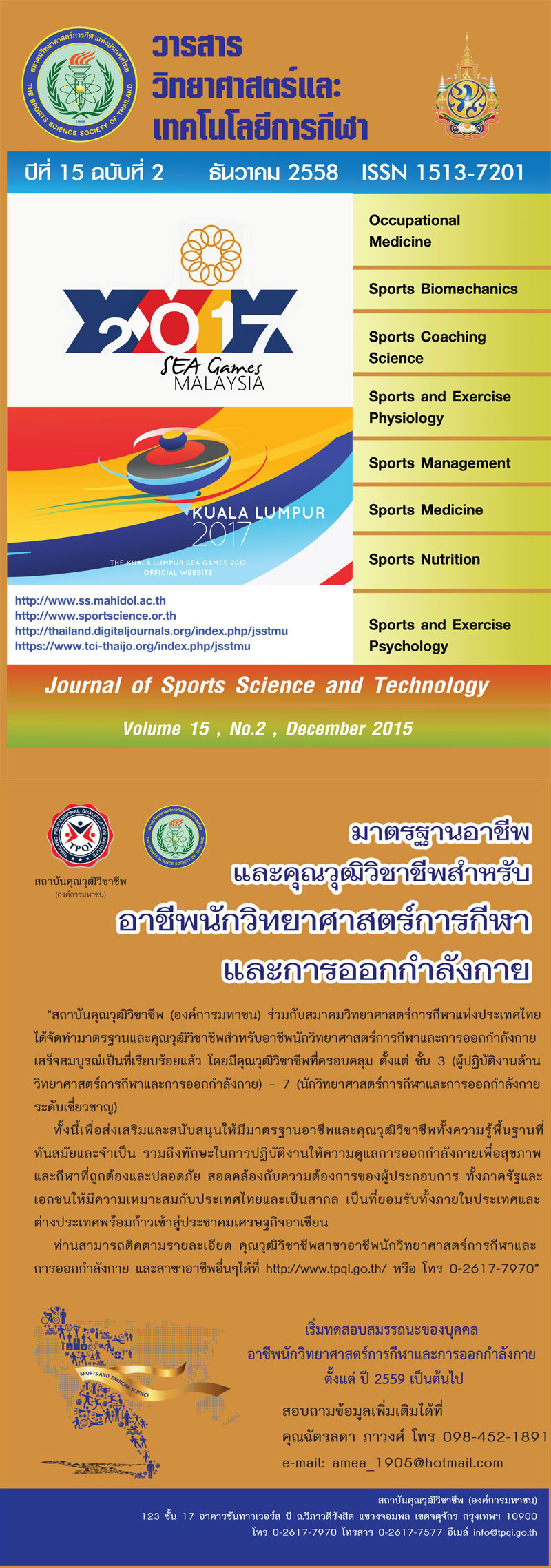THE PHYSICAL FITNESS NORMS OF THAI UNIVERSITY ATHLETES
คำสำคัญ:
Physical Fitness / Norm / Thai University Athletesบทคัดย่อ
The purpose of this study was to study the physical fitness of Thai university athletes. A total of 1,247 males and 776 females participants (age range, 18-28 years.,) whom attended the 41th University Games at Kampangsan Campus, Kasetsart University were randomly sampled from a total of 9,963 university athletes. Participants were devided into a sport groups,in cludy groups performed a physical fitness test, which was specific to all 9 sport groups, including group 1 ( football, futsal, rugby, hockey, basketball, handball), group 2 ( volleyball, sepaktakraw, beach volleyball, softball) group 3 ( tennis, badminton, table tennis, dancing) group 4 (boxer, judo, taekwondo, karate, fencing, thaisword) group 5 (petanque, Bridgeton, crossword, checkerboard) group 6 ( throwing, weight lifting) group 7( sprint swimming, rowing) group 8 ( sprinter and jumper) and group 9 ( long distance swimming and running). After measuring their physical fitness test, all data were analyzed and presented as mean and standard deviation and as percentage to establish physical fitness norms of all sports groups.
The results showed that Hand strength was greatest in short and long distance swimmers (group 7 and group 9) compared with other sports groups. However, leg muscle strength, flexibility, leg muscle power, speed, and aerobic and anaerobic capacity was greatest in sprinters (group 8). Agility was found to be greatest in racket sports. Field sports (group 6) demonstrated a greater hand muscle power compared with other sports groups. The results from this study can be used as a guideline for the improvement of physical fitness in Thai university athletes.
(Journal of Sports Science and Technology 2015; 15(2); 145-158)
ดาวน์โหลด
เผยแพร่แล้ว
2015-12-28
รูปแบบการอ้างอิง
1.
KAMUTSRI T, TREERAJ A, SRIWILAI C, NABSANIT J. THE PHYSICAL FITNESS NORMS OF THAI UNIVERSITY ATHLETES. J Sports Sci Technol [อินเทอร์เน็ต]. 28 ธันวาคม 2015 [อ้างถึง 12 มกราคม 2026];15(2):145-58. available at: https://he01.tci-thaijo.org/index.php/JSST/article/view/44943
ฉบับ
ประเภทบทความ
Research Article






